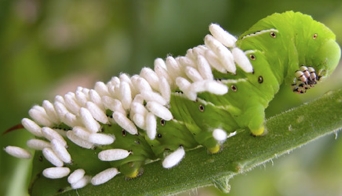Organic and Biological Controls for Pests
This may seem an odd time of year to be talking about pests. Surely the spring is the time when they are most active, and by now you’re pretty safe? Well, yes, to a certain extent. But there are still plenty of pests about, and there will be until the first frosts. And if you have a greenhouse, you will be aware that plenty of minibeasts think it’s perfect, and you’ve even been thoughtful enough to provide a food source!
So what are the real horrors to worry about at this time of year? Well, the main ones are caterpillars, slugs and snails, and vine weevil.
 Slugs, snails and caterpillars you can see. And worse, you can see the damage that they’ve caused, and the mess they leave behind: holes in the leaves of the plants, holes in your tomatoes that rapidly go mouldy, and also slime trails and excreta all over your plants. But in a way, where you can see, you can act. Search your plants for caterpillars and pick them all off. Be ruthless and squash them.
Slugs, snails and caterpillars you can see. And worse, you can see the damage that they’ve caused, and the mess they leave behind: holes in the leaves of the plants, holes in your tomatoes that rapidly go mouldy, and also slime trails and excreta all over your plants. But in a way, where you can see, you can act. Search your plants for caterpillars and pick them all off. Be ruthless and squash them.
Slugs and snails are harder to find, because they are good at hiding during the day. Try searching when it’s raining, or after watering and pick them off. If you can’t be bothered, you can set traps: buy a ‘beer trap’ or make your own using a low tray (a Chinese takeaway tray is ideal) and setting it into the ground so that the edges are flush with the soil. Fill it with beer and check it every day. Alternatively, put down slug pellets. Those with ferric phosphate as the active ingredient are safe for children and pets. Another alternative is nematodes. More effective against slugs than snails, because snails don’t tend to live in the soil, these arrive as a dry powder that you rehydrate and water on. One application now will certainly cut down the number of slugs overwintering in your garden and greenhouse!
Usually, the first sign of vine weevil is dead plants. The weevils lay their eggs in soil, usually in plant pots, the larvae eat the roots of the plants, and the plants die. And although you may not be worrying too much about your summer tubs, which have almost finished, it may be worth worrying if you’ve planted up your winter tubs already. In which case, buy some vine weevil-specific nematodes and water the containers thoroughly with them. Vine weevil grubs seem to love bulbs and cyclamen in particular; you have been warned! And if you do get vine weevil, empty out your tubs, and refill with new compost, which you can buy from compost suppliers (click here if you need compost), and replant any plants that still have roots. Don’t try to salvage the old compost, as it may contain unhatched eggs.